The Results Are In. And So…..
“Effective leadership is not about making speeches or being liked; leadership is defined

“Effective leadership is not about making speeches or being liked; leadership is defined by results, not attributes.” — Peter Drucker
The last post addressed the system tangibles of reviewing performance, the key metrics that provide an unvarnished quantification of the health of your organization. The metrics are the facts, but there is one last question that must be answered: how do you interpret them?
Performance is all about context, and the context is embodied in the plan to achieve your stated goals. Plans, and planning, can take on a life of their own, which we can’t recommend (see the post on PDCA). Plans reflect your commitment to make outcomes happen intentionally, as opposed to just being carried along with the drift.
Comparing results to goals should be easy, whether you’re doing it at the enterprise level or any slice of it. Doing it graphically makes it easiest of all. Obviously, this is just an example… pick your own key metrics.

In a glance, you can see where you’re performing against plan. And rather than have the exercise degenerate into show-and-tell (“Look, mom/dad!! What a good job I did!!”), the facts speak for themselves. Commentary doesn’t improve the metrics. A failed objective with a good explanation is not as good as meeting – or beating – your goals.
So how do you interpret these facts? And what do you do about it?
If you’re on or ahead of plan, STOP TALKING. The leader is making it happen… let her get back to work.
If you’re way ahead of plan, consider raising the bar. It might be time to set a stretch goal that can become a vivid example of what’s possible.
If you’re below plan, your spider diagram is to be followed by a Corrective Action Plan. This plan is very lean:

It’s tempting to spend time critiquing performance, but sticking to this framework keeps everyone focused on actual results and less on commentary. We’re all inclined to think about how to make things better. Empower the front line to make a zillion fast improvements while the leadership sets sights on bigger (aka strategic) efforts, or anything needing more than a small team to accomplish.
Your business unit or organization doesn’t exist in a vacuum but in a competitive ecosystem. Evaluating performance includes seeing how you’re doing against the competition. For public companies (of which there are fewer every year), this is relatively easy. For all others it can be more challenging but there are always sources of information. But don’t become obsessed with competitors, taking the example of Netscape. Former managers there said they would have been better served by paying more attention to what their top customers wanted than fretting over what Microsoft was planning with Internet Explorer.
Consider benchmarking against the best in any industry. The classic case of benchmarking was Xerox’s insight that they should learn best fulfillment processes from LL Bean, not other office product makers. When you learn from the experience of others, your improvement takes a higher trajectory… a virtuous cycle you want to sustain.
Rinse and repeat. Back to work.
“Effective leadership is not about making speeches or being liked; leadership is defined
“Some of us will do our jobs well and some will not, but
“Never tell people how to do things. Tell them what (needs to be
We helped an emerging growth technology services company to expand a line of business by creating alignment across the organization, clarify the value proposition to leverage strengths, focus on training for developing people, and execute the plan, starting.
We answer all email and requests as they come in. If you have an urgent matter or would like to place an order please click the link below to give us a call.
We help you sustain your Management Advantage by coaching and mentoring your leadership team to adopt management practices from the best performing organizations – and lots of learning we’ve acquired in decades of experience.
Subscribe to get the latest news, activities and deals directly to your email address.